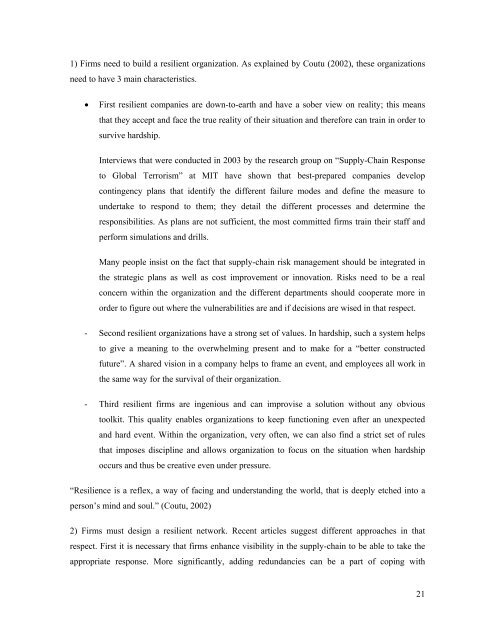Managing Risks of Supply-Chain Disruptions: Dual ... - CiteSeerX
Managing Risks of Supply-Chain Disruptions: Dual ... - CiteSeerX
Managing Risks of Supply-Chain Disruptions: Dual ... - CiteSeerX
You also want an ePaper? Increase the reach of your titles
YUMPU automatically turns print PDFs into web optimized ePapers that Google loves.
1) Firms need to build a resilient organization. As explained by Coutu (2002), these organizationsneed to have 3 main characteristics.• First resilient companies are down-to-earth and have a sober view on reality; this meansthat they accept and face the true reality <strong>of</strong> their situation and therefore can train in order tosurvive hardship.Interviews that were conducted in 2003 by the research group on “<strong>Supply</strong>-<strong>Chain</strong> Responseto Global Terrorism” at MIT have shown that best-prepared companies developcontingency plans that identify the different failure modes and define the measure toundertake to respond to them; they detail the different processes and determine theresponsibilities. As plans are not sufficient, the most committed firms train their staff andperform simulations and drills.Many people insist on the fact that supply-chain risk management should be integrated inthe strategic plans as well as cost improvement or innovation. <strong>Risks</strong> need to be a realconcern within the organization and the different departments should cooperate more inorder to figure out where the vulnerabilities are and if decisions are wised in that respect.- Second resilient organizations have a strong set <strong>of</strong> values. In hardship, such a system helpsto give a meaning to the overwhelming present and to make for a “better constructedfuture”. A shared vision in a company helps to frame an event, and employees all work inthe same way for the survival <strong>of</strong> their organization.- Third resilient firms are ingenious and can improvise a solution without any obvioustoolkit. This quality enables organizations to keep functioning even after an unexpectedand hard event. Within the organization, very <strong>of</strong>ten, we can also find a strict set <strong>of</strong> rulesthat imposes discipline and allows organization to focus on the situation when hardshipoccurs and thus be creative even under pressure.“Resilience is a reflex, a way <strong>of</strong> facing and understanding the world, that is deeply etched into aperson’s mind and soul.” (Coutu, 2002)2) Firms must design a resilient network. Recent articles suggest different approaches in thatrespect. First it is necessary that firms enhance visibility in the supply-chain to be able to take theappropriate response. More significantly, adding redundancies can be a part <strong>of</strong> coping with21
















